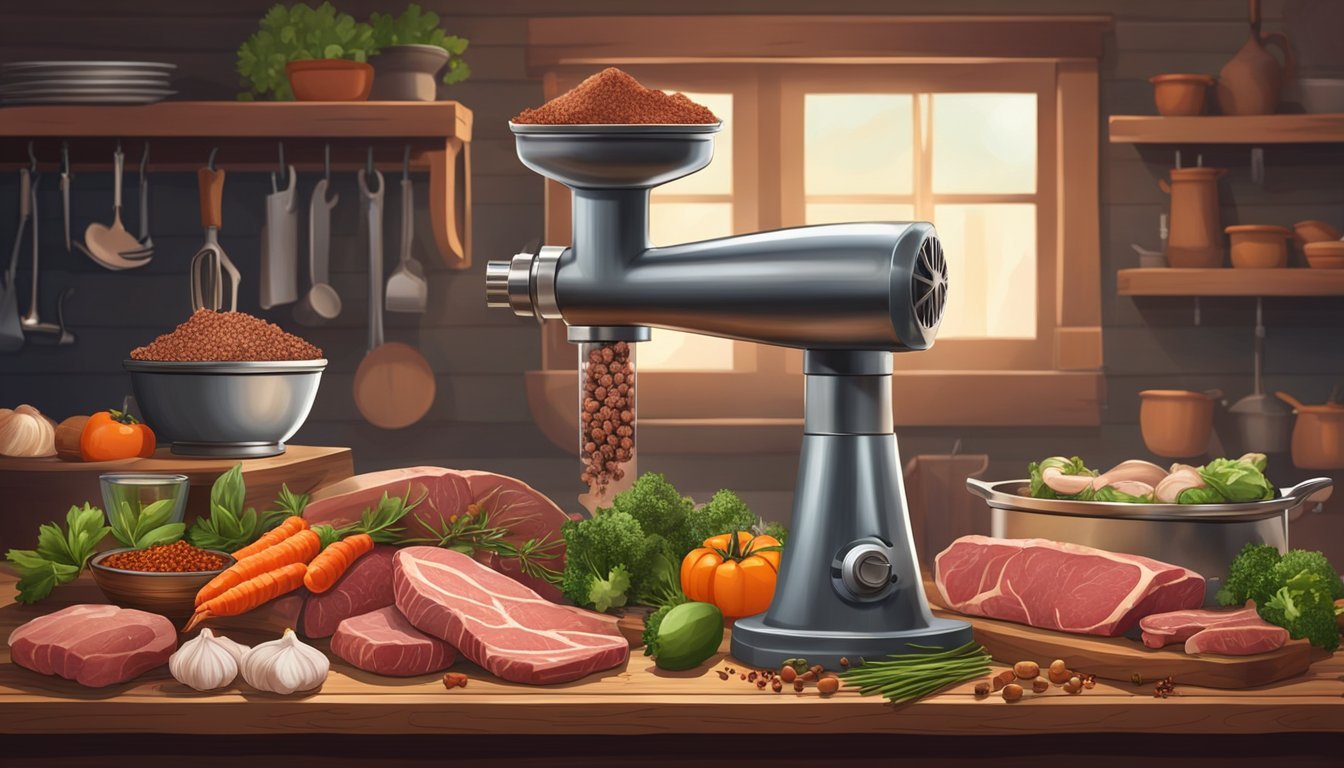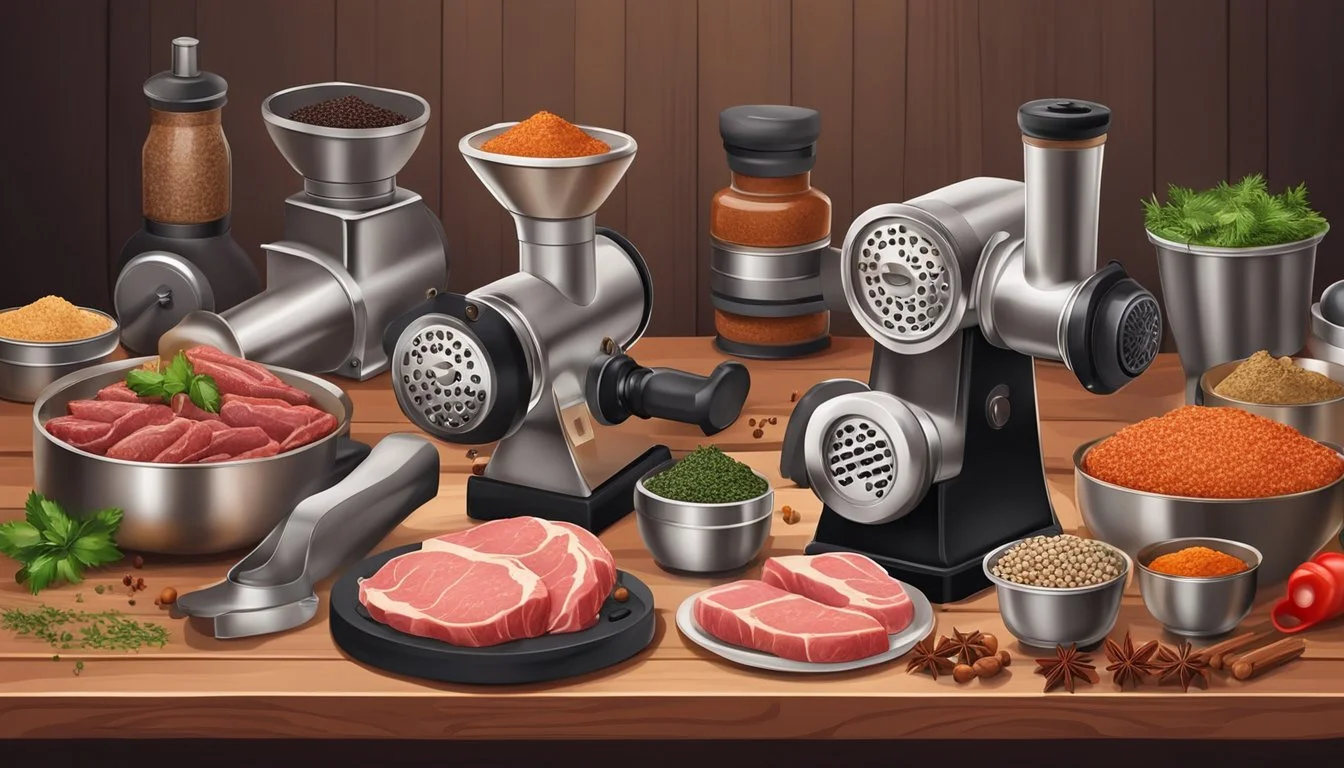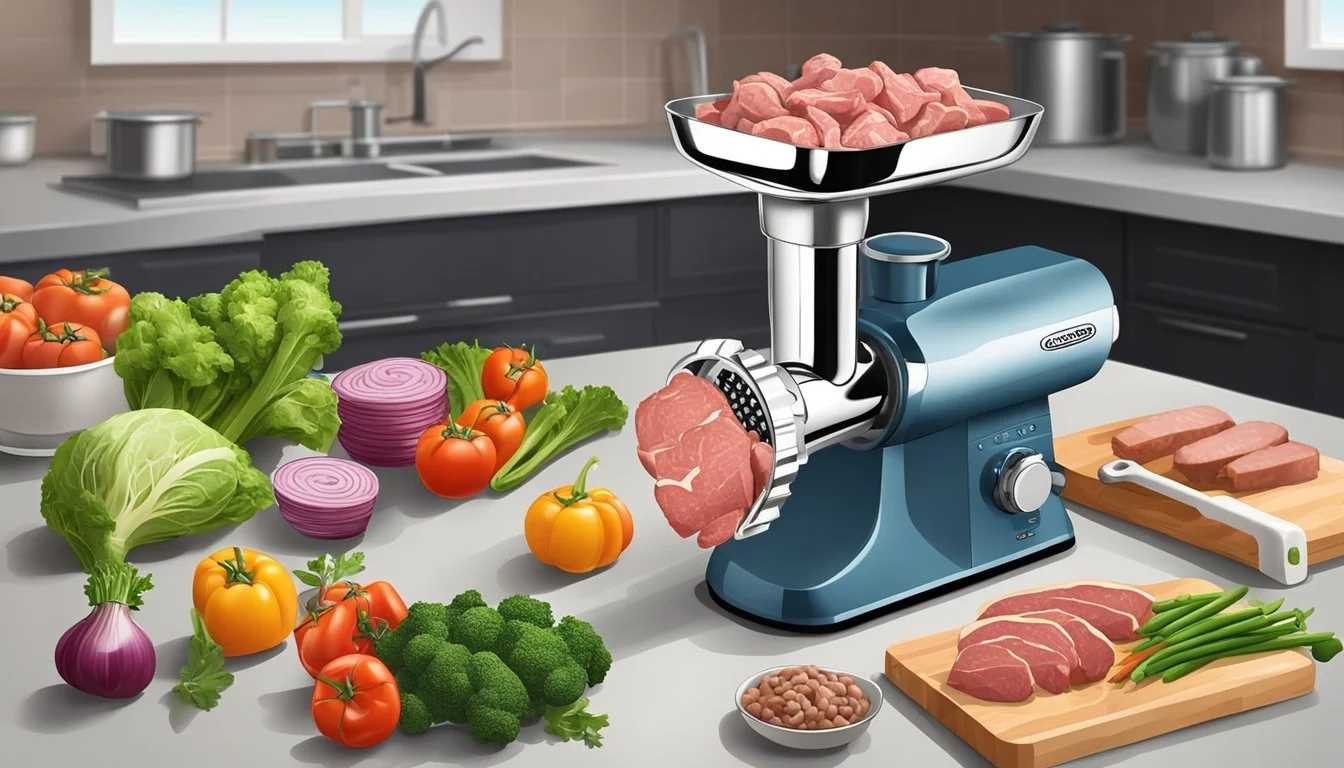Ultimate Guide to Choosing and Using a Meat Grinder for Homesteading
Essential Tips for Self-Sufficient Living
For homesteaders, the ability to process and prepare food sustainably is a key component of self-sufficiency. One tool that has become essential in this pursuit is the meat grinder. This piece of equipment offers homesteaders the chance to turn their home-raised livestock into a variety of meat products, from ground beef for burgers to filling for sausages. Quality meat grinders provide both versatility in preparation and control over the ingredients, ensuring healthier and more flavorful results than store-bought alternatives.
Choosing the right meat grinder can be daunting, given the range of options available on the market. Electric meat grinders offer convenience and power, suitable for those who process meat frequently. They come equipped with various attachments and settings that allow for different textures and consistencies. On the other hand, manual meat grinders appeal to those who may not require such frequent use or who prefer the hands-on approach it offers. It's essential that a meat grinder, whether manual or electric, is durable, easy to clean, and appropriate for the volume of meat to be processed.
As integral tools in the homesteader's kitchen, meat grinders not only provide a means to utilize every part of an animal, but they also add value to the homestead by enabling the creation of artisanal meat products that could be sold or bartered. With this guide, homesteaders can confidently navigate the options to find a meat grinder that fits their needs, whether they are looking to ensure the quality of their family's food or expand their homesteading ventures.
Why Grind Your Own Meat
Grinding one's own meat allows for a higher degree of control over both the quality and the blends of meat in dishes such as hamburgers and sausages. By selecting precise cuts of meat, individuals ensure the flavor and texture meet their specific preferences, leading to a more delicious and tailored dining experience.
Choice of Cuts: Selecting specific cuts allows consumers to manage the fat content and blend different types of meat, depending on their recipe needs.
Flavorful Blends: By grinding meat at home, it's possible to create unique mixtures, such as blending beef with bacon or lamb for a more complex flavor profile.
Freshness: Ground meat deteriorates faster than whole cuts; thus, grinding meat when needed ensures optimum freshness and taste.
Grinding meat at home also underscores the importance of cleanliness—consumers control the sanitation of their environment and the utensils used, potentially reducing the risk of foodborne illnesses.
Hygiene: One can ensure that all equipment is thoroughly cleaned and the meat is handled properly every step of the way.
Incorporating freshly ground meat in recipes results in dishes that are fresher and often perceived as superior in quality and taste. Home cooks are encouraged to chill their grinder parts before use—it maintains a cold environment essential for a consistent grind, keeping the fat solid and preventing unpleasant texture changes.
Lastly, individuals can personalize the texture of their ground meat by adjusting the coarseness settings on their grinders—a feature often lost with pre-ground store-bought meat.
Types of Meat Grinders
When choosing a meat grinder for homesteading, it's crucial to understand the two main types available: manual and electric grinders. Each offers distinct advantages and is suited to different user needs and preferences.
Manual Meat Grinders
Manual meat grinders are a cost-effective and energy-independent option. They require no electricity, making them ideal for use in remote locations where power may not be reliable. These grinders often feature stainless steel construction, which is durable and resistant to corrosion. A standard manual grinder typically includes various accessories, such as different plate sizes for fine or coarse grinding and sausage-making attachments.
Pros:
Does not require electricity
Portable
Often more affordable
Cons:
Requires manual effort
Not suitable for large volumes of meat
Electric Meat Grinders
Electric meat grinders provide efficiency and convenience, especially when processing large quantities of meat. They are powered by motors rated in watts, with higher wattage indicating more powerful and capable units. These grinders may come with a range of accessories to enhance versatility, including different grinding plates and attachments for making sausages, kibbeh, and more. Users should look for models that emphasize reliable performance and easy cleaning.
Pros:
Effortless grinding
Suitable for large batches
Often includes a variety of attachments
Cons:
Dependent on electricity
Typically more expensive than manual models
Might be larger, requiring more storage space
Key Features to Consider
When selecting a meat grinder for homesteading, one must assess various features to ensure the grinder meets their food processing needs. Factors such as grinder size, motor power, and durability directly impact the appliance's performance and longevity.
Grinder Size and Capacity
The size and capacity of the meat grinder determine how much meat one can process in a single session. A larger grinder can handle more substantial quantities, making it ideal for those who process large batches. Typical home meat grinders range from #5 to #32, with the number indicating the size of the grinding plate.
Motor Power
Motor power is crucial as it affects the grinder's ability to process tough cuts of meat. Electric grinders with a higher wattage motor can grind more quickly and effortlessly. For continuous and heavy-duty use, one should look for a model with at least 500 watts.
Durability and Materials
Meat grinders should be built to last. Look for grinders constructed with stainless steel body and blades to ensure durability and prevent rusting. Quality materials contribute to the item's longevity and consistent performance.
Ease of Cleaning
Ease of cleaning is essential to maintain hygiene. Grinders should disassemble easily, with stainless steel parts often being dishwasher safe. Pay attention to the design of the components to ensure there are no hard-to-reach areas that could harbor meat residue.
Attachments and Accessories
A variety of attachments and accessories can enhance the functionality of a meat grinder. Look for models that come with different sizes of grinding plates, sausage-stuffing tubes, and kibbeh attachments to maximize the variety of foods one can prepare. The availability and quality of these accessories can greatly expand the appliance's versatility.
Grinder Maintenance and Care
Maintaining a meat grinder is essential for its longevity and functionality. Proper cleaning, rust prevention, and regular inspections can ward off a majority of potential issues.
Cleaning Your Grinder
Thorough cleaning after each use is vital to keep a meat grinder in top condition. One should always disassemble the grinder, starting with the hopper and moving down to the feeding tube, cutting blades, and plates. It’s best to wash these parts by hand using warm, soapy water and a brush specifically designed to reach all the nooks and crannies. After washing, parts should be dried immediately to prevent rust formation and then coated with food-grade oil before storing.
Steps for Cleaning a Meat Grinder:
Disassemble and soak all parts.
Scrub each piece with a soft cleaning brush.
Rinse thoroughly with warm water.
Dry each component completely.
Apply food-grade oil on metal parts.
Store in a dry place.
Preventing and Removing Rust
Rust is a common enemy of metal tools, and prevention is key. Users should ensure that all metal components are thoroughly dried before oiling. Food-grade mineral oil can be applied to protect against rust. If rust does occur, it can be removed using a mixture of baking soda and water. Apply this paste onto the rusted area, let it sit, and then scrub gently with a brush or cloth. Afterward, rinse and dry the parts thoroughly, then apply a coat of oil.
Rust Prevention Tips:
Store grinder parts in a dry environment.
Use food-grade mineral oil to coat metal sections.
Do not allow water to sit on metal parts.
Regular Inspection and Repair
Every use should be followed by a detailed inspection of the grinder's components. One should look for any signs of wear on the blades, discoloration on metal parts, and resistance in the machinery when assembled. Any worn parts should be replaced immediately to keep the grinder working efficiently. Regular maintenance could include tightening screws and bolts, replacing dull blades, and ensuring that the motor (if electric) runs smoothly without overheating.
Inspection Checklist:
Check blades for dullness or damage.
Look for discoloration or corrosion on metal parts.
Ensure moving parts operate smoothly.
By adhering to these specific maintenance routines, one can ensure their meat grinder remains reliable and ready to use, preserving the quality of ground meat for all homesteading needs.
Grinding Techniques and Tips
When homesteaders grind their own meat, certain techniques contribute to the ease of the process and quality of the final product. Insistence on proper preparation, blade selection, and meat type consideration ensures an excellent grind fit for creating hamburgers and sausage alike.
Preparing the Meat for Grinding
Before the meat encounters the grinder, one must prepare it adequately. Firstly, meat should be cleaned thoroughly, with excess fat and any undesirable parts discarded. Secondly, chilling the meat is crucial. Sliced meat should be spread out on a baking sheet and placed in the freezer for 30-60 minutes until firm but not frozen solid. This step reduces smearing during grinding and keeps the fat intact.
Selecting and Using Blades
The blades or cutting plates of the grinder largely dictate the texture and quality of the grind. For instance, a coarse plate is typically used for a rustic, chunky texture suitable for sausages, while a fine plate is preferable for creating a smooth hamburger patty. Blades must be icy-cold before use, which can be achieved by chilling them alongside the meat. A sharp blade contributes to efficient grinding and prevents unnecessary strain on the grinder motor.
Grinding Different Types of Meat
When grinding different types of meat, understanding their unique characteristics is essential. While beef is robust and often grinds well, poultry can be trickier due to its softer texture and potential to become pasty. One should grind poultry on a higher speed setting to ensure a clean cut. If a homesteader desires to mix meats for flavor depth or textural variance in their hamburger or sausage, they should alternate the meats during grinding to ensure an even distribution.
Incorporating these techniques into the meat grinding process empowers homesteaders to effectively produce high-quality ground meat for a variety of culinary applications.
Beyond Meat: Other Homestead Uses
A meat grinder isn't just for preparing human meals; it serves crucial roles on a homestead that promote sustainability and self-sufficiency. It can transform various raw materials into practical products for both animals and the garden.
Creating Homemade Pet Food
By grinding their own meat, homesteaders ensure high-quality nutrition for their livestock and pets. They can use a meat grinder to combine meats, grains, and vegetables to create balanced pet food that caters specifically to the dietary needs of their animals. This custom blend often results in healthier pets and can lead to increased longevity.
Assisting with Garden Composting
Meat grinders can be instrumental in a homestead's composting system. Grinding vegetable scraps and other compostable food waste before adding them to the compost pile helps to accelerate the decomposition process. This results in nutrient-rich compost that can greatly benefit the homestead's garden.
Processing Harvest for Canning
Grinding fruits and vegetables during the canning process can make preserving the harvest more efficient. Homesteaders can produce a variety of textures for canning items such as sauces, purees, and jams. They can also ensure the homestead has a continuous supply of shelf-stable foods through the seasons.
Sausage Making Basics
Making sausage at home is a process that combines quality meat grinding with seasoning finesse and stuffing proficiency. The homesteader can produce distinctive sausage flavors and textures using their own tools, ensuring a high standard of the end product.
Casings and Seasonings
Casings provide the structure for the sausage and come naturally from animal intestines or can be made synthetically. To prepare natural casings for use:
Soak in water for 30 minutes to become pliable.
Slide one end onto the stuffer nozzle, pushing the entire length onto it, leaving a 6-inch overhang.
Seasonings are essential for flavor. When homesteaders grind their own meat, they can create custom seasoning blends. A basic guideline for seasoning mixture:
1.5% salt by weight of the meat
Spices and herbs to taste
Stuffing Techniques
The key to stuffing is to develop an even, consistent filling without air pockets. Tools such as a sausage stuffer or meat grinder with a stuffing attachment are necessary.
Steps to stuff sausages:
Prepare meat by grinding it through a medium or coarse plate.
Mix with chosen seasonings.
Chill the mixture before stuffing to maintain the texture.
Fill casings evenly, avoiding overstuffing.
Twist into links at regular intervals, if desired.
By following these techniques and paying attention to detail, homesteaders can create high-quality sausages tailored to their personal tastes.
Homesteading and Self-Sufficiency
Homesteading reflects a lifestyle choice to live in a more self-sufficient and sustainable manner. Tools and equipment are at the heart of this practice, enabling homesteaders to effectively manage their resources and projects. A typical homestead may encompass tasks such as growing vegetables, raising livestock, and preserving food.
Kitchen tools, like a good quality meat grinder, are essential for processing and preparing food. Homesteaders often value equipment that is reliable and multipurpose, thus a meat grinder serves not only to grind meat but can be used for making sausages, grinding other food items, and even crafting pet food.
When it comes to livestock, the animals are an integral part of a self-sustaining homestead. They provide meat, milk, eggs, and at times, labor. The introduction of a meat grinder helps in fully utilizing an animal’s resources. Bones and meat scraps, often wasted, can be ground for various uses, reflecting the homestead’s ethos of minimizing waste.
Homesteaders usually choose equipment that is durable and easy to maintain. A meat grinder fits into this category, especially when parts are straightforward to clean and replace. Moreover, the ability to repair such tools on the homestead minimizes dependence on external services.
Here are some critical aspects of homesteading equipment:
Versatility: Equipment should serve multiple purposes.
Durability: Longevity is critical for reducing replacement costs.
Ease of Maintenance: Simple to clean and repair ensures continuous usage.
Efficiency: Tools should improve productivity and not hinder processes.
Through self-sufficiency, homesteaders gain autonomy over their food and lifestyle, and equipment choices are a testament to this principle. The meat grinder, therefore, is not just a kitchen tool but a symbol of self-reliance and capability.
Meat Grinder Safety and Precautions
When using a meat grinder, safety should never be an afterthought. It is a powerful tool that requires attention to certain precautions to prevent injury and ensure proper operation.
Before Use:
Inspection: Examine the meat grinder for any signs of damage.
Assembly: Confirm that all components are correctly assembled before use.
During Use:
Temperature: To maintain the integrity of the meat and equipment, keep both meat and grinder parts chilled.
Operation:
Use a food pusher, never fingers, to feed meat into the grinder.
Make sure to turn off and unplug the grinder when not actively grinding.
After Use:
Cleaning: Disassemble and clean all parts thoroughly to prevent bacterial growth.
Storage: Store the equipment in a dry place to avoid rusting.
Do:
Wear cut-resistant gloves
Make sure the grinding area is free of water
Use the proper settings for the type of meat
Don't:
Leave the grinder plugged in when not in use
Force the meat into the grinder
Neglect cleaning the machine
To prevent accidents, one should not distract themselves while the grinder is in use. Operators should be trained in the correct use of the meat grinder, which includes understanding how to handle the meat, the operation of the grinder itself, and what to do in case of a jam.
Employers and users must ensure that the equipment has the necessary safeguards, such as a fixed guard, to protect users from the moving parts. Regular maintenance is essential to keep the meat grinder in optimal condition and to uphold a safe working environment.
Choosing the Right Grinder for Your Needs
When selecting a meat grinder for homesteading, the first consideration should be the quality of the tool. A high-quality grinder ensures durability and efficient operation over time. They should look for devices with robust construction, typically made of stainless steel or heavy-duty aluminum.
For homesteaders, the volume of meat processing is a critical factor. They must assess whether a manual grinder suffices or if an electric grinder is necessary for larger quantities. Electric grinders offer speed and ease, but manual grinders provide finer control and can operate without electricity.
Here's a breakdown of the main considerations:
Volume: Estimating the typical quantity of meat to process will help in choosing between manual and electric models.
Durability: Opt for grinders made of high-grade materials to withstand regular use.
Maintenance: Select a grinder that is easy to disassemble and clean, ensuring longevity and hygiene.
Accessories: Consider additional attachments for versatility in grinding different types of meat and other foods.
Manual Grinder
Pros: No electricity needed, more control
Cons: Labor-intensive, slower
Electric Grinder
Pros: Fast, less effort
Cons: Requires power, can be more expensive
Homesteaders should also be aware of the size of the grinding plates, as these affect the final grind's coarseness. Smaller holes produce finer grinds suitable for sausages, while larger holes are ideal for coarser grinds used in ground meat recipes.
Ultimately, they should select a grinder that balances function, favorability, and financial considerations, contributing positively to their self-sufficient lifestyle.







